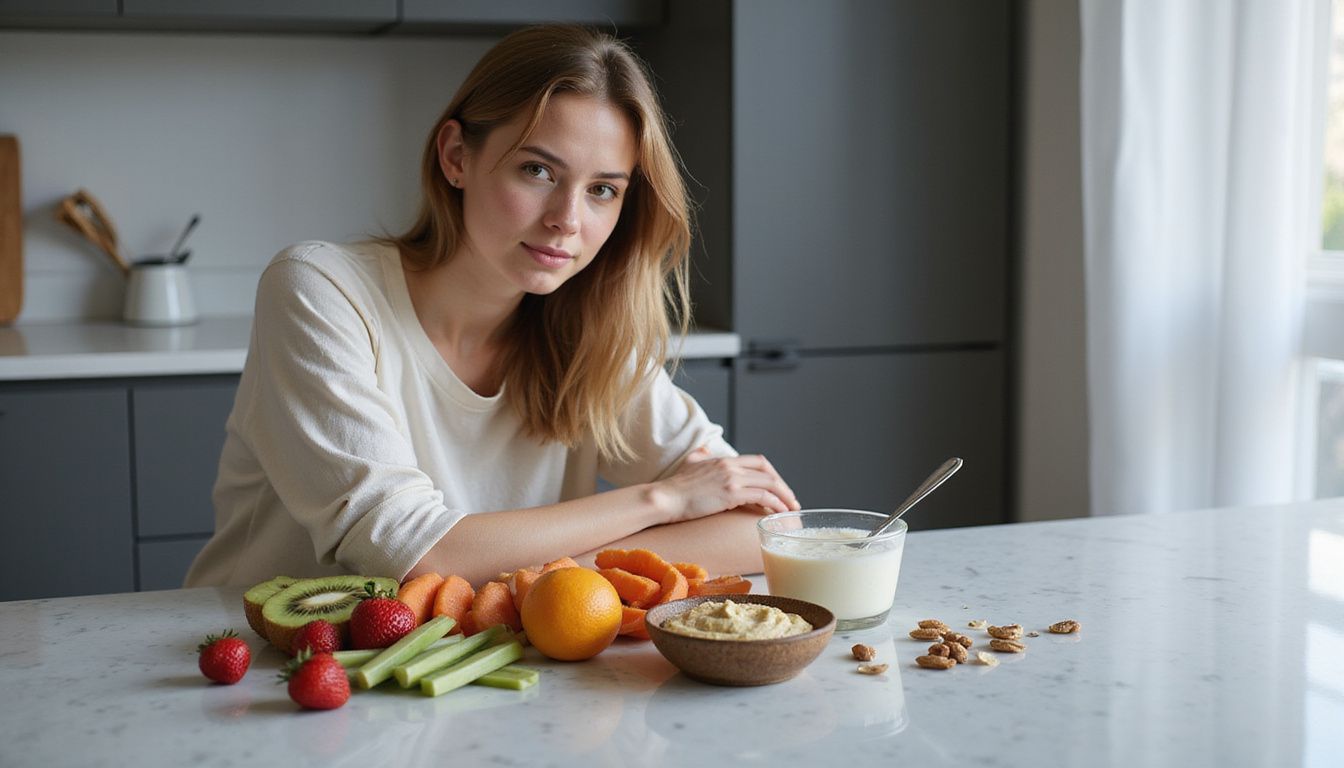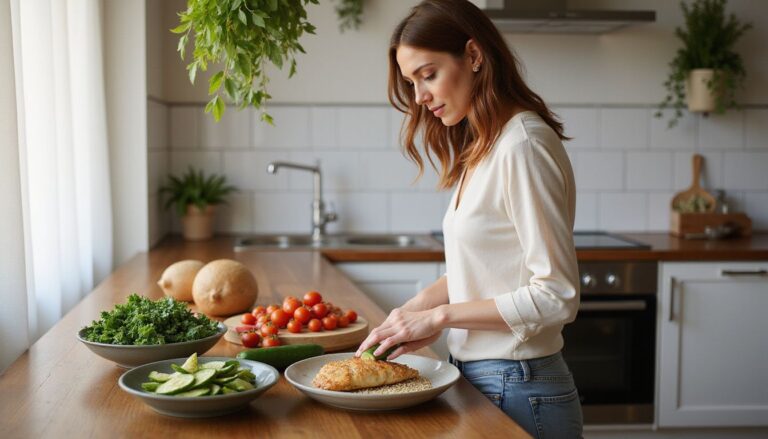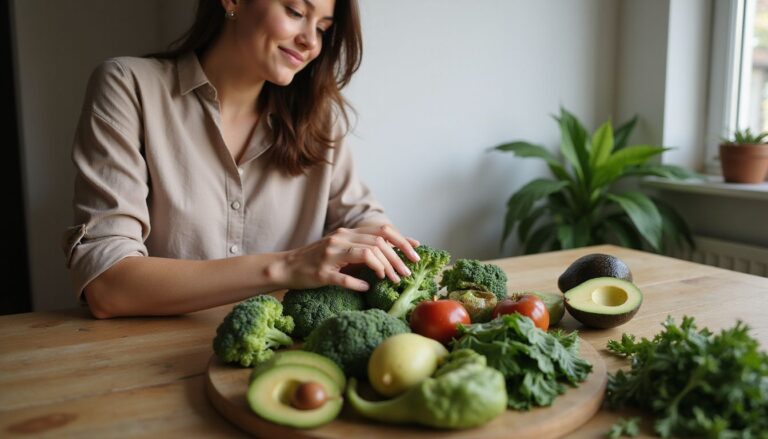100 Calories Or Less: Top Healthy Low Calorie Snacks For Guilt-Free Indulgence
Our Nutrition Assistant AI Suite will transform your body. You will lose fat, get toned, and build muscle. Gain confidence and optimal health.
You grab a quick snack after school or work, then worry the calories will add up. Many packaged foods load in added sugar, fat, or sodium, which can raise your calorie count and stall progress.
Healthy low-calorie snacks with 100 calories or less help you stay satisfied without guilt. You will find clear tips, serving sizes, nutrition facts, and simple snack recipes using whole foods like fruit, vegetables, Greek yogurt, popcorn, nuts, hummus, apple slices with peanut butter, and cottage cheese.
Use these ideas to beat cravings and stay full until your next meal.
Key Takeaways
- Snacks with 100 calories or less, such as 14 almonds or 1 cup of grapes, help manage hunger and support weight goals.
- Protein and fiber are key. For example, 1/2 cup edamame delivers 8 grams of protein and 4 grams of fiber.
- Portion control matters. Three cups of air-popped popcorn sit near 90 to 100 calories, but large handfuls or toppings raise totals fast.
- Research in 2022 found that higher protein snacks can cut hunger by up to 60 percent before the next meal.
- Look for “low-sodium” or “unsweetened” options like plain Greek yogurt or raw nuts to reduce added sugar and salt.
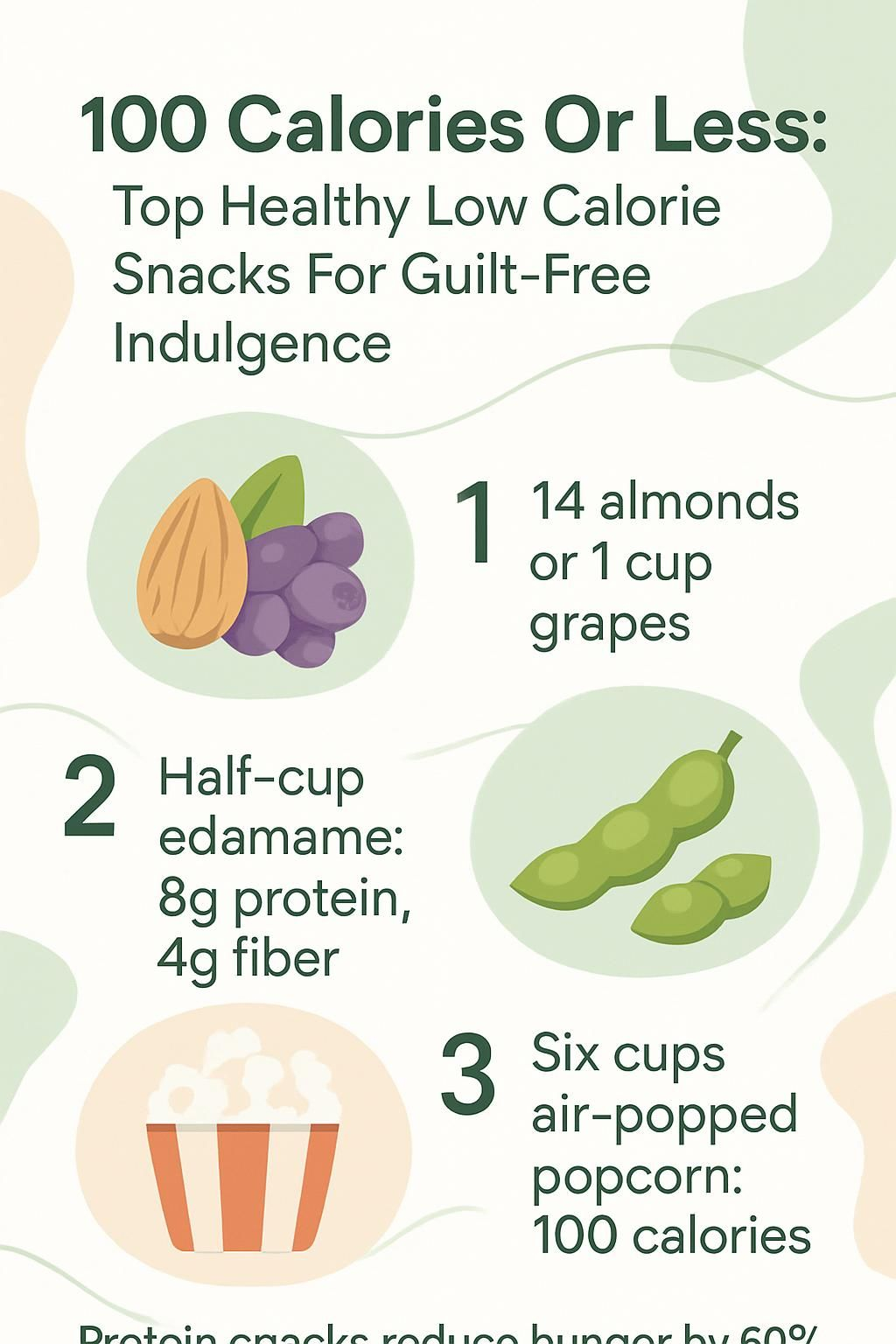
The Role of Snacks in a Balanced Diet
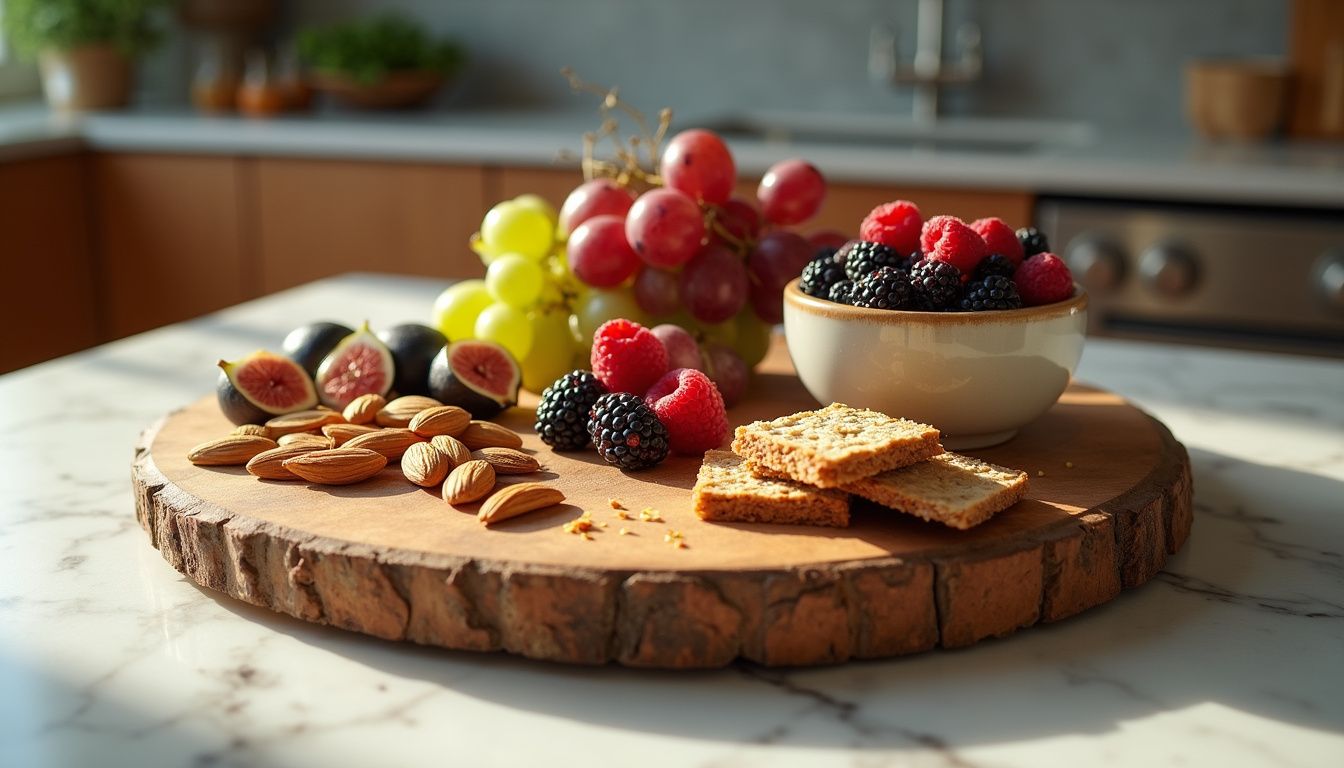
Snacks can be a helpful part of a healthy diet. The right choices steady your energy and manage hunger between meals. Picking nutrient-rich foods gives you more nutrition per bite.
How can snacks help prevent overeating?
Mindful snacking helps you avoid overeating at meals. Combine protein, fiber, and a little healthy fat for longer fullness, for example whole-grain crackers with low-fat cheese or Greek yogurt with sunflower seeds.
A 2022 study showed high-protein snacks reduce hunger by up to 60 percent before the next meal. Stable blood sugar also helps. Fruits, vegetables, edamame, and cottage cheese give steady energy and make impulse grabs less likely.
Prepping portion-controlled snacks ahead of time limits mindless eating. Exploring low-calorie options gives you more choices you can enjoy without worry.
What are the benefits of low-calorie snacks?
Low-calorie snacks, like baby carrots with hummus or one cup of grapes, satisfy hunger while keeping your total daily calories in check. You still get vitamins, minerals, fiber, and protein that support weight management.
People who pick nutrient-rich snacks such as fruit, chickpea items, or Greek yogurt often feel fuller and eat less at meals. Foods with higher water content, like cantaloupe or watermelon, also hydrate while offering a sweet bite.
Smart snacks provide quick energy without sharp blood sugar spikes. A small handful of almonds or air-popped popcorn can prevent the afternoon crash and keep you focused.
Low-calorie diet snacks also tame cravings for high-fat treats. Many options are easy to prep, so you have something ready between meals.
Choosing low-calorie snacks full of fiber and protein keeps both appetite and energy steady, says registered dietitian Amy Gorin.
Next, see how fiber and protein can improve every snack choice you make.
Tips for Choosing Healthy Low-Calorie Snacks
Smart snack choices help you meet nutrition goals and manage hunger. Focus on dietary fiber, protein, and healthy fats. These nutrients make a healthy snack that is under 100 calories feel more satisfying.
Why focus on fiber and protein in snacks?
Protein and fiber slow digestion, so you stay full longer. That helps with appetite control and heart-healthy eating. For example, 1/2 cup edamame has 8 grams of protein and 4 grams of fiber under 100 calories.
Try Greek yogurt, hummus with vegetables like cherry tomatoes or bell peppers, or 14 almonds for a balanced mix of both nutrients.
High-fiber foods help prevent energy dips. Choosing this combo makes each bite count without adding much saturated fat.
A quick example: after soccer practice, I mix low-fat cottage cheese with fresh berries. It keeps me full until dinner and adds calcium with a creamy taste.
How can portion sizes affect snack calories?
Portion size can change your calorie count more than you think. Six whole-grain pretzel sticks equal a 100-calorie serving. Eating more quickly raises the total. The same is true with popcorn. Three cups of air-popped popcorn are around 90 to 100 calories. Extra handfuls or toppings can double that fast.
Pre-portion snacks to keep calories in line. Even healthy foods like trail mix, nuts, or dried fruit add up if you do not measure them.
For instance, twenty pistachios are about 80 calories. Several handfuls can push you into high-calorie territory before you notice. Keep small containers ready so you can pack quick snack packs on busy days instead of dipping into a large bag.
One extra handful might seem harmless until you realize you doubled the calories, says dietitian Rachel Johnson.
Foods like ricotta cheese or slow-churned ice cream show why measuring matters. Using small bowls or pre-set amounts helps you enjoy favorite snacks while sticking to your target when hunger hits between meals.
How to minimize added sugar and sodium in snacks?
Pick products labeled “low-sodium” or “unsweetened.” Low-sodium tomato soup and unsweetened peanut butter are easy swaps for salty or sugary staples.
Skip cream-based soups and sweetened cereals to avoid hidden sugar and salt. A half-cup nonfat yogurt with a teaspoon of unsalted sunflower seeds gives protein with 0 mg sodium and no added sugar.
Choose plain, nonfat Greek yogurt over flavored types to cut sugar without losing protein or creamy texture. Buy raw or dry-roasted nuts with no salt listed in the ingredients to limit sodium.
Make simple dips at home, like hummus with garlic and olive oil, to control salt. Use these ideas to build flavor while avoiding unnecessary additives.
Next up, try fruit-forward snacks like apple slices with peanut butter for a naturally sweet and balanced choice under 100 calories.
Fruits: Nature’s Guilt-Free Snack
Fruit brings natural sweetness, fiber, and antioxidants. It is easy to build snack recipes that stay under 100 calories and boost your vitamin intake.
How to enjoy apple slices with peanut butter under 100 calories?
Apple slices with peanut butter give a sweet, creamy snack that stays under 100 calories. You get fiber, protein, and healthy fat for steady energy.
- Measure 3/4 cup apple slices for about 55 to 60 calories. Pick crisp types like Fuji or Honeycrisp.
- Add 2 teaspoons unsalted peanut butter, about 30 calories. Check the label for no added sugar or oils.
- Pair apple fiber with peanut butter protein and fatty acids to stretch fullness.
- Slice apples right before eating, or add lemon juice so they do not brown in a lunchbox.
- Spread or dip lightly so each bite has a bit of peanut butter.
- Unsalted peanut butter keeps sodium low; add a dash of cinnamon or chia seeds if you like.
- This snack has about 0.8 grams saturated fat and no cholesterol. It delivers vitamins and protein to keep you satisfied between meals.
What is a healthy frozen banana pop recipe?
Frozen banana pops are cool, creamy, and simple. They fit neatly into a low-calorie snack plan.
- Cut a ripe banana in half. Each half is usually under 55 calories.
- Dip each half in 1 ounce low-fat plain yogurt for about 25 more calories.
- Roll in 1 tablespoon finely crushed oats or chia seeds to add fiber and texture.
- Insert a wooden stick and place on parchment for easy cleanup.
- Freeze for two hours. You get a crisp shell with a creamy center.
- Each pop stays under 80 calories with very little saturated fat and sodium.
- The mix delivers potassium from bananas and protein from strained yogurt, no added sugar needed.
- For variety, add a few mini dark chocolate chips or chopped nuts, keeping portions small.
- These pops hit the sweet spot while supplying nutrients from whole foods.
- They store well in the freezer and taste great on hot days.
How to make a watermelon and feta salad snack?
Watermelon and feta make a fast, refreshing snack. It hydrates and satisfies under 100 calories.
- Cut 1 cup of watermelon cubes to keep calories low and boost hydration.
- Add 1 tablespoon crumbled feta for protein, calcium, and a savory contrast.
- Top with chopped fresh mint for aroma and almost no extra calories.
- Drizzle with 1/2 teaspoon balsamic vinegar to bring out sweetness without sugar.
- Add a pinch of black pepper if you want a mild kick.
- Toss gently so each bite brings fruit, cheese, and herb.
- Eat soon for best texture. Watermelon softens if it sits too long.
- Stick to one cup of watermelon and one tablespoon feta to keep it below 100 calories, based on USDA estimates.
- For healthy fats, add two small avocado cubes, but use sparingly to stay near the target.
- This snack provides vitamin C from fruit and calcium from cheese while supporting calorie control.
Is 1 cup of grapes a good low-calorie snack?
Yes. One cup of grapes is about 100 calories, so tracking is easy. Grapes are low in saturated fat, very low in sodium, and cholesterol free.
You also get fiber plus vitamin K and manganese. Their high water content helps you feel full without added sugar from desserts.
Try freezing them for a cool bite after exercise. They pack well, need no peeling, and hold you over until your next meal.
Vegetables: Crunchy and Satisfying
Vegetables bring crunch and volume with very few calories. Snack on colorful options for fiber and key vitamins.
Why choose baby carrots with hummus as a snack?
Eight baby carrots with hummus land near 100 calories with minimal saturated fat and no cholesterol. Hummus supplies plant protein. Carrots add crunch and fiber that extend fullness without a big calorie hit.
You also get vitamin A from carrots and minerals from legumes. It is a fast, portion-controlled bite that supports a healthy diet.
How to enjoy 1 cup jicama sticks with salsa?
Jicama with salsa is crisp, juicy, and low in calories. It makes a smart option for mindful eaters.
- Fill a cup with jicama sticks for about 54 calories and almost no saturated fat.
- Pair with a low-sodium salsa. A small serving usually adds less than 30 calories.
- Wash, peel, and slice jicama into stick shapes for easy dipping.
- Scoop salsa into a small bowl. Aim for 235 mg sodium or less per serving.
- Dip each stick rather than pouring salsa on top to control sodium.
- Jicama has high water content, so it is filling without heaviness. It fits vegan eating and many other patterns.
- Pack it for school or work. It is convenient, crunchy, and under 100 calories.
Jicama sticks with salsa give you crunch and satisfaction with zero cholesterol and very low saturated fat.
What are bell pepper ‘sandwiches’ and how to make them?
Bell pepper “sandwiches” use pepper slices in place of bread, so you get big flavor for few calories.
- Slice one large bell pepper into wide, flat panels to make your “slices.”
- Fill with hummus, part-skim mozzarella, or lean turkey for protein.
- Add thin cucumber or tomato slices for extra crunch and freshness.
- Skip bread and stay under 100 calories per serving while loading up on vitamins A and C.
- This gluten-free idea is great if you are cutting refined grains.
- Top with cracked black pepper or a sprinkle of sunflower seeds for healthy fats and texture.
- Pair with a few whole-grain crackers if you need more fiber without many extra calories.
Bell peppers are botanically fruits but used as vegetables in the kitchen. They deliver fiber, vitamin C, and antioxidants.
How to prepare cucumber slices with Greek yogurt dip?
Cucumber with Greek yogurt dip is hydrating and protein rich. It is easy to make and store.
- Slice one medium cucumber into rounds or sticks.
- Measure 1/2 cup plain, nonfat Greek yogurt. You get about 12 grams of protein and around 60 to 80 calories.
- Stir in 1 teaspoon honey for light sweetness while keeping sugar low.
- Add chopped dill or mint for flavor without added sodium.
- Dust with black pepper or paprika if you want more taste.
- Serve the cucumber with the yogurt dip on the side.
- Refrigerate leftovers in an airtight container for up to two days.
- Cucumber is low calorie and hydrating. Pairing it with high-protein yogurt supports recovery after exercise.
- Switch herbs or add lemon juice to keep the dip interesting.
Next, see how a hard-boiled egg and fruit can deliver protein and fiber in a tidy, portable snack.
Protein-Packed Snacks
Protein-packed snacks help control hunger and support muscle health. A small amount goes a long way when you choose wisely.
How to combine hard-boiled eggs and fruit for a snack?
A hard-boiled egg plus fresh fruit makes a balanced, portable plate. You get protein, healthy fat, fiber, and antioxidants for around 100 calories.
- Slice one hard-boiled egg and add 1/2 cup sliced strawberries or apple slices for natural sweetness and vitamin C.
- Pack it in a small container to keep portions controlled if you eat on the go.
- Add a sprinkle of black pepper or smoked paprika for flavor without extra salt.
- Wash fruit well before eating.
- Optional: want crunch. Add 3 almonds, which nudges calories just above 100, so use only if your target allows it.
- This combo blends protein from the egg with fruit fiber, which helps you stay full longer.
Is cottage cheese and cantaloupe a healthy option?
Yes. Half a cup of cottage cheese with cantaloupe cubes is about 100 calories with roughly 14 grams of protein and less than 1 gram of saturated fat. It is satisfying yet light.
Cottage cheese brings protein and calcium. Cantaloupe adds hydration and vitamins without too much sugar. It is a quick, cooling choice that helps manage hunger between meals.
How to enjoy Greek yogurt with sunflower seeds?
Greek yogurt with sunflower seeds offers creaminess and crunch. It is easy to keep under 100 calories.
- Choose nonfat Greek yogurt for protein with very little fat.
- Spoon 1/2 cup into a bowl, about 60 calories.
- Top with 2 teaspoons unsalted sunflower seeds, about 34 calories, landing near 94 total.
- Pick unsalted seeds to limit sodium.
- Stir gently so you keep some crunch.
- Use this snack before studying or a workout to support focus and muscles.
- Add a few berries or a drizzle of honey only if you need more sweetness, then watch the calories.
- Pack small containers in advance for fast access on busy days.
This approach gives you protein, healthy fats, and texture without breaking your calorie budget.
What are smoked salmon pinwheels and their benefits?
Smoked salmon pinwheels are savory and elegant. Spread 1 tablespoon low-fat cream cheese on thin salmon slices, roll them up, then cut into bite-size pieces.
Each pinwheel is typically under 60 calories. Sodium can be high in smoked salmon, often 200 to 300 milligrams per piece, so keep portions small or choose lower-sodium salmon.
Two small pinwheels stay under the 100-calorie mark. You get protein and omega-3 fats, which support heart health. Serve with crunchy vegetables or a few whole-grain crackers.
Nuts and Seeds: Small but Mighty
Nuts and seeds deliver protein, fiber, and healthy fats in a tiny package. Portion control keeps them within your calorie limit.
How many almonds make a 100-calorie snack?
Fourteen whole almonds land near 98 calories. They are low in saturated fat, sodium free, and cholesterol free.
Almonds supply unsaturated fats, protein, and fiber that help with fullness. Count out your portion into a small dish for easy control. This simple habit reduces the urge to grab higher-calorie treats later.
For variety, try pistachios next time.
Are 20 pistachios a good low-calorie choice?
Yes. A serving of 20 pistachios has about 80 calories. You get protein, fiber, and healthy fats with very little saturated fat and minimal sodium if unsalted.
Pistachios also provide vitamin B6, potassium, and magnesium. They travel well and beat a cookie or cracker when you want something crunchy.
What is a healthy trail mix with nuts, seeds, and dried fruit?
Trail mix can be energizing if you keep portions small and ingredients simple.
- Choose 1/4 cup of mix with unsweetened dried fruit and a few dark chocolate chips, plus unsalted walnuts.
- Include pumpkin or sunflower seeds for crunch and protein.
- Use dried berries without added sugar.
- Pick raw or dry-roasted nuts like almonds, pistachios, or walnuts.
- Skip candy pieces and yogurt drops to avoid added sugar.
- Aim for about 28 grams total to stay near 100 calories.
- Check labels on pre-made mixes for salt and sugar.
- Pre-portion into small containers to prevent overeating.
On a long drive, having single-serve trail mix made it easy to pass on gas station candy while keeping energy steady.
How to include pumpkin seeds as a snack?
Pumpkin seeds are rich in protein, fiber, magnesium, and zinc. They help you stay full and support overall health.
- Choose unsalted roasted pumpkin seeds for crunch without extra sodium.
- Measure 1 tablespoon, about 56 calories, for a portion under 100.
- Sprinkle on Greek yogurt or blend into a berry smoothie for extra minerals.
- Mix into your favorite trail mix with nuts and dried berries.
- Top salads or cottage cheese with a spoonful for texture and taste.
- Store in an airtight container for freshness and easy grab-and-go snacking.
- Combine a spoonful with air-popped popcorn for a crunchy bowl that stays near your goal.
These ideas make it simple to enjoy pumpkin seeds while staying aligned with a healthy plan.
Creative Snack Combos
Creative pairings keep snack time interesting. Mix textures like creamy and crunchy to feel satisfied on fewer calories.
How to make a cheese-stuffed pita pocket snack?
This small pita pocket is quick, filling, and fiber rich. It relies on whole grains and part-skim dairy to stay around 100 calories.
- Use half of a small whole-grain pita to boost fiber and hold calories down.
- Spread 1 tablespoon part-skim ricotta cheese inside. That adds about 0.8 grams saturated fat and modest sodium.
- Spread evenly so every bite has flavor.
- Add sliced tomato or fresh spinach for extra taste with almost no calories.
- Pick whole-grain pitas instead of white for more nutrients and steady energy.
- For crunch, tuck in a few thin cucumber slices.
- Stick to one half-pita to match the nutrition target.
- It packs well for work or school and curbs hunger fast.
For more variety, try a tomato and mozzarella jar that you can assemble ahead and grab anytime.
What are tomato and mozzarella jars, and how to prepare them?
Tomato and mozzarella jars travel well and taste fresh. They bring color, protein, and calcium to your snack lineup.
- Use a small glass jar with a tight lid to keep ingredients crisp.
- Layer cherry tomatoes, mini mozzarella, and torn basil leaves.
- Measure about 6 to 8 tomatoes and 3 small mozzarella balls to stay under 100 calories.
- Drizzle 1 teaspoon olive oil or balsamic for extra flavor without many calories.
- Season lightly with salt and pepper to control sodium.
- Use part-skim mozzarella to keep fat lower while keeping protein.
- Mix gently so each bite has tomato, cheese, and basil.
- Refrigerate up to two days and pair with whole-grain crackers if you want more crunch.
This simple jar delivers flavor and nutrients in a portable format that fits a busy day.
How to enjoy edamame steamed or roasted?
Edamame is a versatile soybean snack with a sturdy dose of protein and fiber.
- Measure 1/3 cup shelled edamame, about 100 calories with 8 grams protein and 4 grams fiber.
- Rinse under cold water before cooking. Fresh or frozen both work.
- Steam for five minutes, then sprinkle lightly with sea salt if desired.
- Or roast at 400°F for about 15 minutes until crisp, then season with black pepper.
- Experiment with both textures. Steamed feels light, roasted feels like a crunchy treat.
- Use garlic powder or smoked paprika for variety. Keep added oil low.
- Refrigerate leftovers in an airtight container for quick grab-and-go snacking.
This fast option is low in saturated fat and naturally very low in sodium unless you add salt.
What makes a blueberry smoothie a low-calorie snack?
A blueberry smoothie can hit your 100-calorie target with a short ingredient list. You get antioxidants from berries and protein from yogurt.
- Blend 1/3 cup nonfat yogurt with 2/3 cup frozen blueberries to land near 100 calories.
- Keep saturated fat at 0 grams and sodium low.
- Enjoy antioxidants that help protect your cells.
- Nonfat yogurt adds protein and calcium, keeping the drink light.
- Chill for a refreshing feel. It is a nice alternative to heavier desserts.
Next, explore sweet treats that satisfy cravings while staying within your goal.
Sweet Treats Under 100 Calories
You can enjoy dessert-style bites without blowing your plan. These sweet snack ideas focus on flavor, portion control, and simple ingredients.
How much slow-churned ice cream fits under 100 calories?
Half a cup of slow-churned ice cream fits under 100 calories. This portion has about 2 grams saturated fat, modest sodium, and a small amount of cholesterol.
Slow-churned styles are lighter than regular ice cream. Scoop into a small bowl to signal a single serving. The taste satisfies while the portion keeps your calorie count in check.
How to make dark chocolate-drizzled strawberries?
Dark chocolate-drizzled strawberries combine fruit fiber with cocoa antioxidants. They deliver a sweet flavor for very few calories.
- Wash and dry five medium strawberries.
- Melt 1 teaspoon dark chocolate in the microwave for about 30 seconds, then stir.
- Place strawberries on parchment paper.
- Drizzle thin lines of chocolate with a spoon or fork.
- Chill for at least 10 minutes so the chocolate sets.
- Keep to the portion to stay within your calorie budget.
- Pack them for a quick, heart-friendly treat that is low in sodium and fat.
What is a frozen yogurt sandwich and is it low calorie?
A frozen yogurt sandwich is cool and creamy with fewer calories than many desserts.
- Spread 2 tablespoons nonfat yogurt between two whole-grain graham crackers.
- Freeze until firm. One sandwich is about 84 calories.
- It is very low in saturated fat and cholesterol compared to ice cream treats.
- Whole-grain crackers add a bit of fiber.
- The set portion prevents overeating and makes planning easier.
- Make several at once and freeze for fast, portion-controlled sweets.
This dessert is easy to personalize with different yogurt flavors while keeping added sugar low.
How to prepare chia pudding with berries?
Chia pudding thickens in minutes and brings fiber, protein, and omega-3 fats from the seeds.
- Stir 1 tablespoon chia seeds, about 60 calories, into 1/2 cup unsweetened almond milk.
- Mix well to remove clumps.
- Refrigerate for at least 30 minutes until thick.
- Add a small handful of fresh berries to stay under 100 calories total.
- Flavor with a pinch of cinnamon or a drop of vanilla extract.
- Make several jars ahead for a quick snack after a workout.
The creamy texture and natural fruit sweetness make this a steady-energy option.
Savory Low-Calorie Options
Savory choices add variety and are often high in fiber or protein. These ideas keep portions and sodium in check while staying near 100 calories.
Are six whole-grain pretzel sticks a good snack?
Yes. Six whole-grain pretzel sticks total about 100 calories. Whole grains offer more nutrients than refined ones. This serving has low saturated fat, moderate sodium, and no cholesterol.
Sodium can add up fast with pretzels, so stick to the serving. They travel well for busy afternoons at school or work.
How many cups of air-popped popcorn equal 100 calories?
Three cups of air-popped popcorn contain about 90 to 100 calories. You get a big bowl for very few calories, thanks to fiber and tiny amounts of fat.
For movie night, use an air popper and season with herbs, nutritional yeast, or a light sprinkle of grated Parmesan. One tablespoon of Parmesan adds about 20 calories, which keeps the snack near the target while boosting flavor.
Avoid butter or heavy salt if you want your low-calorie snack to stay heart friendly.
Nutritional Summary per 3 cups:
- Calories: about 90 to 100
- Carbohydrates: about 24 grams
- Fiber: about 6 grams
- Saturated fat: less than 0.5 gram
- Sodium: negligible unless salted
Air-popped popcorn proves you can have a crunchy, satisfying snack with hardly any extras.
How to enjoy half a baked potato with salsa?
Half a medium baked potato with salsa offers savory flavors and fiber for about 80 calories.
- Scrub the skin well to keep the fiber.
- Pierce the potato with a fork. Microwave 4 to 5 minutes until tender.
- Cut in half and scoop a little flesh if you want to trim calories further.
- Top with 2 tablespoons tomato salsa. This adds flavor with very little fat.
- Skip butter, cheese, and sour cream to stay under 100 calories.
- Enjoy hot. Mix salsa into each bite for even flavor.
- Potatoes bring potassium and fiber, which make this snack more filling than many chips.
What are the benefits of roasted chickpeas as a snack?
Roasted chickpeas give you a crunchy, savory bite plus plant protein. A small serving, about 1/3 cup, can fit under 100 calories while providing roughly 5 to 6 grams of protein and about 4 to 5 grams of fiber.
Choose unsalted or lightly seasoned versions to limit sodium. You also get minerals like iron, magnesium, and potassium. Pack a small container to avoid vending machine snacks at work.
Additional Tips for Healthy Snacking
Planning ahead removes guesswork. With a few simple habits, you can keep low-calorie choices ready whenever hunger strikes.
How to prep snacks ahead of time effectively?
Prepping snacks helps control portions and reduces overeating. A short weekly routine saves time and supports better choices.
- Wash, cut, and portion fruits and vegetables at the start of the week. Use reusable containers for grab-and-go packs.
- Pre-portion dry snacks like nuts, seeds, air-popped popcorn, or whole-grain pretzel sticks to keep servings under 100 calories.
- Use measuring cups or a kitchen scale so servings match your goals.
- Prep protein options such as hard-boiled eggs or cottage cheese cups for quick access.
- Group ready-made snacks in a visible spot in the fridge or pantry to cue better choices.
- Assemble combos like veggie sticks with yogurt dip or fruit with nut butter in single-serving packs.
- Set aside 30 minutes weekly. Meal prep is linked with fewer last-minute, less healthy choices.
- Use clear containers to see what is left and reduce waste.
- Label with dates so you eat older items first.
- Rotate flavors to prevent boredom and support a wider mix of nutrients.
How to experiment with flavors and combinations in snacks?
Mix flavors and textures to keep snacks exciting. Try sweet-salty pairs, like fruit with a small piece of cheese, or crunchy-creamy pairs, like carrots with hummus.
Add sunflower seeds to Greek yogurt for crunch, or sprinkle pumpkin seeds over cottage cheese. Use spices, citrus zest, or fresh herbs in place of sugar or salt. For a global twist, top a baked potato with salsa or use tzatziki as a veggie dip.
Small switches can change the taste without raising calories. Apple slices with peanut butter and a shake of cinnamon, for example, feel cozy and indulgent while staying near 100 calories.
Conclusion
Choosing snacks under 100 calories gives you plenty of room to enjoy food and still meet health goals. Low-calorie snacks like Greek yogurt, almonds, baby carrots with hummus, and air-popped popcorn help keep you full, curb cravings, and limit added sugar and sodium.
Measure portions, scan Nutrition Facts labels, and prep ahead to make smart snack ideas the easy choice. Try fresh combinations such as cottage cheese with cantaloupe or bell pepper “sandwiches” to keep your routine interesting.
This article is for general information and is not medical advice. If you have specific health needs or a medical condition, talk with a registered dietitian or your healthcare provider.
Healthy snacking is a skill you can practice daily. With a few low-calorie favorites ready to go, you can enjoy flavor, stay energized, and feel confident about your choices.
Sources: USDA FoodData Central, 2023 updates; peer-reviewed research on protein-rich snacks and satiety, 2022.
FAQs
1. What are some top healthy snacks under 100 calories for guilt-free indulgence?
Many nutritious options fit this category, such as Greek yogurt with berries, air-popped popcorn, carrot sticks with hummus, and a small apple. Each snack provides vitamins or fiber while keeping calorie intake low. According to the USDA FoodData Central database, one cup of air-popped popcorn contains about 31 calories and a medium-sized apple has roughly 95 calories.
2. How can I make sure my low-calorie snack is actually healthy?
Check nutrition labels for added sugars and unhealthy fats. Choose whole foods like fruits or vegetables over processed items. A study in the Journal of Nutrition found that diets rich in whole foods support better health outcomes than those high in processed snacks.
3. Are packaged snacks labeled “low calorie” always good choices?
Not all packaged products marketed as “low calorie” offer nutritional value; many contain artificial ingredients or lack important nutrients like protein and fiber. For example, rice cakes may be low in calories but provide little satiety compared to nuts or dairy-based options.
4. Can eating several small snacks under 100 calories help manage hunger throughout the day?
Eating smaller portions more often can help control appetite if you choose nutrient-dense foods that satisfy hunger without excess energy intake. In my own experience as a dietitian working with clients seeking weight management strategies, spreading out balanced mini-meals helped them avoid overeating at main meals.
Summary: Healthy snacking under 100 calories is possible when selecting whole food options rich in nutrients rather than relying on marketing claims alone; reading labels and focusing on quality supports both satisfaction and wellness goals.

